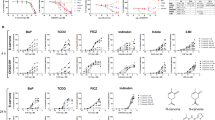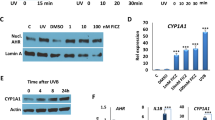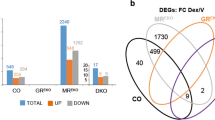Abstract
The potent tumour promoter 12-O-tetradecanoyl-phorbol-13-acetate (TPA), and related phorbol ester tumour promoters, act by binding to specific high affinity receptors on the cell surface and this leads to changes in cell membrane structure and function, as well as highly pleiotropic effects on gene expression1–3. The ability of the phorbol ester tumour promoters4–7, and of a recently discovered tumour promoter, teleocidin8, to induce inhibition of the binding of epidermal growth factor (EGF) to its cell-surface receptors provides a convenient marker for the membrane effects of these tumour promoters. The fact that repeated applications of benzo(a)pyrene (BP) alone to mouse skin will elicit tumours suggests that it can function as both an initiator and a promoter9,10. Thus, in addition to its genotoxic effects, BP might induce membrane effects that resemble those seen with tumour promoters. Indeed, we have found that BP and certain other polycyclic aromatic hydrocarbons (PAHs) are potent inhibitors of EGF-receptor binding in the mouse embryo fibroblast cell line C3H10T½ (ref. 11). As glucocorticoids can inhibit PAH carcinogenesis12,13 and specifically inhibit tumour promotion on mouse skin14,15, we have also examined their effects on EGF receptors. We report here that glucocorticoids alone induce an increase in EGF-receptor binding in C3H10T½ cells and that pretreatment of the cells with a glucocorticoid opposes the inhibitory effects of both TPA and BP. Thus glucocorticoids may inhibit the carcinogenic process by inducing membrane effects that are reciprocal to those induced by carcinogens and tumour promoters.
This is a preview of subscription content, access via your institution
Access options
Subscribe to this journal
Receive 51 print issues and online access
$199.00 per year
only $3.90 per issue
Buy this article
- Purchase on Springer Link
- Instant access to full article PDF
Prices may be subject to local taxes which are calculated during checkout
Similar content being viewed by others
References
Weinstein, I. B. et al. Carcinogenesis; Fundamental Mechanisms and Environmental Effects (eds Pullman, B., Ts'o, P.O.P. & Gelboin, H.) 543–563 (Reidel, Amsterdam, 1980).
Driedger, P. E. & Blumberg, P. M. Proc. natn. Acad. Sci. U.S.A. 77, 567–571 (1980).
Horowitz, A. D., Greenebaum, E. & Weinstein, I. B. Proc. natn. Acad. Sci. U.S.A. 78, 2315–2319 (1981).
Lee, L. S. & Weinstein, I. B. Science 202, 313–315 (1978).
Shoyab, M., DeLarco, J. E. & Todaro, G. J. Nature 279, 387–391 (1979).
Brown, K. D., Dicker, P. & Rozengurt, E. Biochem. biophys. Res. Commun. 86, 1037–1043 (1979).
Lee, L. S. & Weinstein, I. B. Proc. natn. Acad. Sci. U.S.A. 76, 5168–5172 (1979).
Umezawa, K. et al. Nature 290, 411–413 (1981).
Berenblum, I. in Cancer Vol. 1 (ed. Becker, F. F.) 323–344 (Plenum, New York, 1975).
Boutwell, R. K. CRC Crit. Rev. Tox. 2, 419–443 (1974).
Ivanovic, V. & Weinstein, I. B. J. supramolec. Struct., Suppl. 5 (Abstr.) 232 (1981).
Nakai, T. Cancer Res. 21, 221–227 (1961).
Thompson, S. & Slaga, T. J. Eur. J. Cancer 12, 363–370 (1976).
Belman, S. & Troll, W. Cancer Res. 32, 450–454 (1972).
Viaje, A., Slaga, T. J., Wigler, M. & Weinstein, I. B. Cancer Res. 37, 1530–1536 (1977).
Okey, A. B. et al. J. Biol Chem. 254, 11636–11648 (1979).
Poland, A., Greenlee, W. F. & Kende, A. S. Ann. N.Y. Acad. Sci. 320, 214–230 (1979).
Baxter, J. D., & Rousseau, G. C. (eds) Glucocorticoid Hormone Action, 1–22 (Springer, New York, 1979).
Plagemann, G. W. & Renner, E. D. Biochem. biophys. Res. Commun. 46, 816–823 (1972).
Wigler, M., Ford, J. P. & Weinstein, I. B. Symp. on Proteases and Biological Control, 849–856 (Cold Spring Harb. Lab., New York, 1975).
Gelehrter, T. D. Monographs on Endocrinology Vol. 12 (eds Baxter, J. D. & Rousseau, G. G.) 561–574 (Springer, Berlin, 1979).
Baker, J. B. & Cunningham, D. D. J. supramolec. Struct. 9, 69–77 (1978).
Author information
Authors and Affiliations
Rights and permissions
About this article
Cite this article
Ivanovic, V., Weinstein, I. Glucocorticoids and benzo(a)pyrene have opposing effects on EGF receptor binding. Nature 293, 404–406 (1981). https://doi.org/10.1038/293404a0
Received:
Accepted:
Issue Date:
DOI: https://doi.org/10.1038/293404a0
This article is cited by
-
Dexamethasone enhances the effects of parathyroid hormone on human periodontal ligament cells in vitro
Calcified Tissue International (1995)
-
Multistage carcinogenesis: implications for risk estimation
CANCER AND METASTASIS REVIEW (1988)
-
Corticosteroid-induced cleft palate:Cis interaction of MHC genes and hybrid resistance
Immunogenetics (1985)
Comments
By submitting a comment you agree to abide by our Terms and Community Guidelines. If you find something abusive or that does not comply with our terms or guidelines please flag it as inappropriate.



